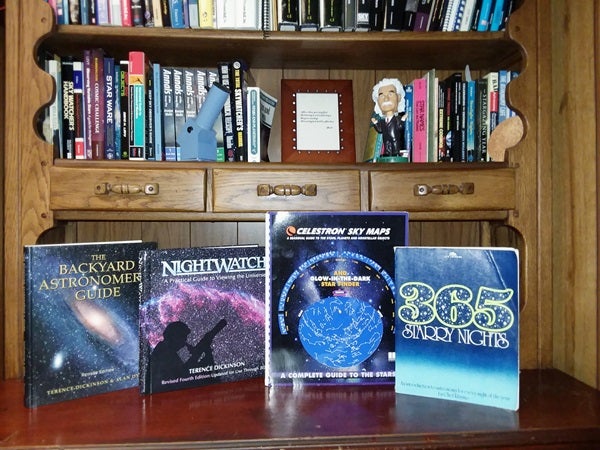This is the problem I faced as I set out to write this month’s column, which highlights guidebooks for the backyard astronomer. By limiting myself to those I could adequately describe in a one-page article, I’d be sure to leave out some goodies. So, with a little trepidation, I’ll begin with a rundown on guides directed toward the novice skygazer (or the veteran who’s looking to brush up).
Foremost in this genre is 365 Starry Nights: An Introduction to Astronomy for Every Night of the Year by Chet Raymo (Prentice Hall, 1982). If your knowledge of astronomy is nil, this book is an essential starting point. As the name indicates, 365 Starry Nights is a night-by-night astronomy primer that helps the reader identify what’s on display in the current night sky, while also adding information on basic cosmology and astronomical history. Entries for March include: an in-depth look at the constellations Cancer, Hydra, and Lynx; an intro to stellar classification; and historical notes on the Messier catalog and Olbers’ paradox.

What we can learn from the life cycles of stars? Astronomy’s free downloadable eBook, Stars: The galaxy’s building blocks contains everything you need to know about how stars live, die, and change their galactic homes over time.
Those two guides alone would suffice to get any newcomer started, but Dickinson also has another handbook, co-authored with Alan Dyer. Not only does their The Backyard Astronomer’s Guide (Firefly Books, revised edition, 2002) mesh nicely with NightWatch, it adds enough advanced material to help the beginner transition to intermediate status. Part 1 deals with equipment, from binoculars and telescopes to eyepieces and accessories. Part 2 handles the basics of observing — naked eye, as well as with optical aid. And part 3 covers advanced tips on digital astrophotography, go-to telescopes, computer-related aids, and telescope maintenance. The Backyard Astronomer’s Guide is regularly updated on its website: www.backyardastronomy.com.
I’m going to throw one more beginner-oriented guide into the mix. Celestron Sky Maps (Hubbard Scientific, 2007) combines two essential tools for the backyard astronomer: a planisphere and a star atlas. A planisphere works like the Star Dome in the middle of each issue of Astronomy, except that it can be adjusted to any date and time of the year. While a planisphere helps you locate a constellation in the sky, a star atlas provides a detailed look at that constellation. The front cover of Celestron Sky Maps is a glow-in-the-dark planisphere, while the main body is an eight-chart atlas arranged by season. Facing each chart is a table describing key deep-space objects plotted on the chart. The guide is printed on heavy cardstock with a protective overcoat for outdoor use, and it’s also spiral bound to allow the charts to lie flat.
The guides in this article can be purchased at your local bookstore or ordered online. Remember, picking up a used edition is always a good idea — it’s more environmentally friendly, and usually costs less.
Alas, as I feared, I’ve run out of room and I’ve only discussed beginner’s guides. Next month, we’ll look at guides geared for the intermediate and advanced skygazer.
Questions, comments, or suggestions? Email me at gchaple@hotmail.com. Next month: guides that list sky objects for binoculars and telescope. Clear skies!










